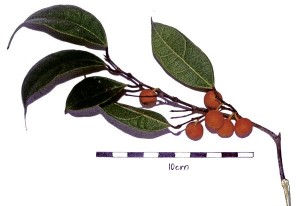Kalapat
 As i hiked up the mountains, I crossed a rolling creek, and waded through grassy fields.
As i hiked up the mountains, I crossed a rolling creek, and waded through grassy fields.
Everything was cut down except for one lone tree. The trunk was large and twisted, and the top was full of long branches with shiny, green elongated leaves and small, bulbous, yellow fruit. It was a balete, the local name generally given to strangler ficus trees. Superstition in these parts had spared it from logging.
Balete trees are believed to be home of gnomes and evil will befall whoever destroys it. How I wish this was a superstition attached to all trees!
Finally, I reached the top and came into a large clearing.
I have always found balete trees especially beautiful. This particular strangler fig is special to me because of its significance in the direction my life was taking.
 Not only did its appealing gnarly trunk and colorful fruit stop me in my tracks when I came upon it that day, but it also was the favorite food of the critically endangered Dulungan hornbill (Aceros waldeni), a bird that had brought me to that place and the conservation work I was embarking on.
Not only did its appealing gnarly trunk and colorful fruit stop me in my tracks when I came upon it that day, but it also was the favorite food of the critically endangered Dulungan hornbill (Aceros waldeni), a bird that had brought me to that place and the conservation work I was embarking on.
Kalapat (Ficus heteropleura) clearly portrays the interdependent nature of rainforest ecosystems, where animals and plants are dependent on each other for their survival. Kalapat is entirely dependent on other species for its existence. It is pollinated specifically by the fig wasp Liporrhopalum dubium (Grandi) and its seeds are dispersed by several species of birds, most notably the Visayan Wrinkled hornbill or Dulungan.
The relationship between the fig wasp and its host plant is a symbiotic one.
Both species benefit from each other: the tree’s flower, which is completely enclosed by the fruit, is pollinated by the fig wasp and in turn the female fig wasp lays its egg in the tree’s fruit.
Ficus heteropleura is the only plant that plays host to the Liporrhopalum dubium fig wasp. Neither species would survive without the other. The plant’s seeds are then dispersed by frugivores, of which the Dulungan is the largest and most prolific disperser. Ficus heteropleura is part of a group of plants of the genus Ficus that are considered keystone species in a tropical forest ecosystem.
It fruits throughout the year, providing nourishment to birds and mammals during the dry season. Ficus heteropleura is extremely easy to grow and is a beautiful ornamental tree. It is perfect for landscaping your biodiversity garden.




















